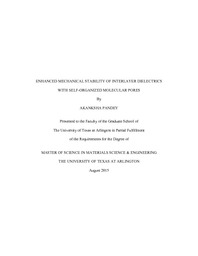| dc.contributor.author | Pandey, Akanksha | en_US |
| dc.date.accessioned | 2015-12-11T23:20:00Z | |
| dc.date.available | 2015-12-11T23:20:00Z | |
| dc.date.issued | 2015 | |
| dc.date.submitted | January 2015 | en_US |
| dc.identifier.other | DISS-13254 | en_US |
| dc.identifier.uri | http://hdl.handle.net/10106/25335 | |
| dc.description.abstract | In order to reduce resistance-capacitance delays in interconnect structures, ultralow-k films are used as interlayer dielectric materials. In most cases the preferred method to achieve the lower dielectric constant is the use of porous carbon doped silicon oxide (p-SiCOH) dielectrics. A downside of porosity in a dielectric layer during device fabrication is that it reduces the mechanical reliability of the dielectric and increases the susceptibility to adsorption of damaging materials. To overcome this and produce a material which can sustain the rigorous processes of fabrication, it is necessary to optimize the mechanical, thermal and chemical properties along with the electrical properties of the dielectric.Processes like CMP that involve high stresses during device fabrication can cause dielectric cracking and delamination. In order to survive these processes dielectric should have sufficient mechanical strength. Apart from this, exposure to high temperature and oxidative plasma during device fabrication can damage and cause failure of the dielectric layer. As per research conducted in our group previously, oxidative plasma environment can make the film hydrophilic and consequently assist in moisture uptake within the film. This increases the dielectric constant of the film substantially and, in essence, nullifies the effort that was put to reduce the dielectric constant in the first place. Also, treatments like annealing or plasma etching can break the long range crosslinking in the material, making it more susceptible towards viscoplastic deformation.In order to achieve the required optimization between the electrical, mechanical, thermal and chemical properties it is necessary to focus on various ways of reducing the dielectric constant and not just the end result of achieving the lower dielectric constant. During the course of this thesis, it has been explained how subtle changes in the fabrication method can cause dramatic changes in the properties of the final product.It has been shown in this thesis that the pores introduced through structural arrangement of atoms can provide much better mechanical and chemical reliability during the fabrication process as compared to the pores introduced through removal of large segments of material from the sample. Electrical properties of the material are measured using ellipsometer and changes in properties with processes like annealing and plasma exposure are discussed in detail. Mechanical properties of the material are measured using nano-indentation and ball indentation tests. To study the molecular structure and changes in molecular structure with processes like annealing, FTIR and XPS techniques are used. An alternative curing method for traditional subtractive films has also been proposed to enhance the material’s resistance to viscoplastic deformation. | en_US |
| dc.description.sponsorship | Kim, Choong-Un | en_US |
| dc.language.iso | en | en_US |
| dc.publisher | Materials Science & Engineering | en_US |
| dc.title | Enhanced Mechanical Stability Of Interlayer Dielectrics With Self-organized Molecular Pores | en_US |
| dc.type | M.S. | en_US |
| dc.contributor.committeeChair | Kim, Choong-Un | en_US |
| dc.degree.department | Materials Science & Engineering | en_US |
| dc.degree.discipline | Materials Science & Engineering | en_US |
| dc.degree.grantor | University of Texas at Arlington | en_US |
| dc.degree.level | masters | en_US |
| dc.degree.name | M.S. | en_US |

